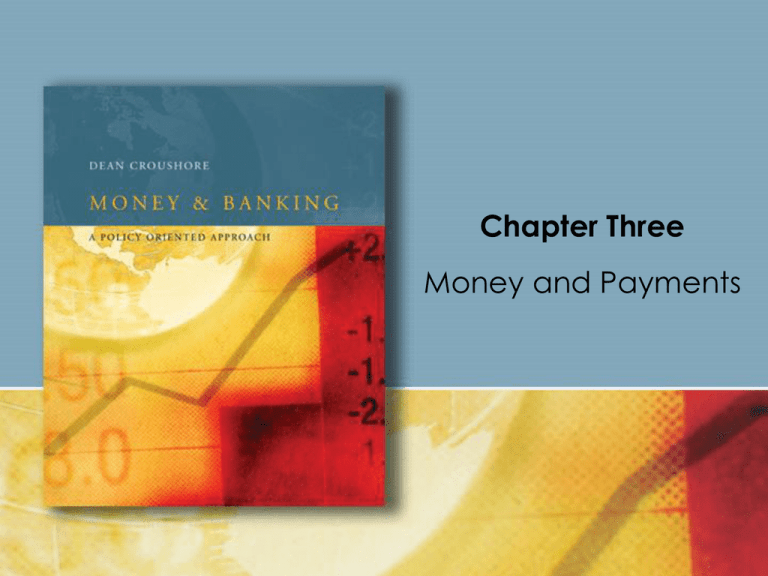
Chapter Three
Money and Payments
How We Use Money
• Medium of Exchange
– lowers transactions costs in exchanges of
goods and services
• Unit of Account
– item in which prices are denoted; useful in
making comparisons among goods
• Store of Value
– money maintains its value, except for inflation
• Standard of Deferred Payment
– loan repayments are stated in money terms
Copyright © Houghton Mifflin Company. All rights reserved.
3|2
The Payments System
• Payments System =
Set of mechanisms
for making
transactions
• Money enables
people to make
exchanges within the
system
Copyright © Houghton Mifflin Company. All rights reserved.
3|3
Outside Money
Created by the government
(currency) or by nature (gold)
• Commodity money = money
with some intrinsic value (also
known as full-bodied money)
– Gold, silver, etc.
– Paper money fully backed by and
redeemable for metal
• Fiat money = money whose
value is decreed by the
government
– No longer backed by metal
– Low cost of production
Copyright © Houghton Mifflin Company. All rights reserved.
3|4
Inside Money
Money created in private sector
• Checking accounts are an example
• Reduces costs of large transactions, provides
a paper trail for receipts and/or tracking fraud
• More complicated than cash because it
requires a clearing mechanism…banks and
the Federal Reserve
• Moving to more electronic money and
electronic clearing of checks
Copyright © Houghton Mifflin Company. All rights reserved.
3|5
Inside Money Transfers
• Costs include long float times (time it takes a
check to travel between banks)
• More checks are now cleared electronically
• Automated clearing house (ACH) systems
use only electronic communication
• Fedwire connects banks to the Federal
Reserve for large electronic transfers
Copyright © Houghton Mifflin Company. All rights reserved.
3|6
Counting Money
• The Federal Reserve monitors amount of money
in circulation, which affects the inflation rate and
overall level of economic activity
• Federal Reserve monetary aggregates
(categorized based on degree of liquidity)
– M1: coins, currency, travelers checks, checking
accounts
– M2: M1 + savings accounts, individual MMMFs, small
time deposits (under $100,000)
– M3: M2 + large time deposits, institutional MMMFs,
repurchase agreements issued by banks, eurodollar
deposits
Copyright © Houghton Mifflin Company. All rights reserved.
3|7
The Fed's Money Measures,
December 2004
Figure 3.1
Copyright © Houghton Mifflin Company. All rights reserved.
3|8
The Fed's Money Measures,
December 2004
Copyright © Houghton Mifflin Company. All rights reserved.
3|9
Growth Rates of the Monetary
Aggregates
Figure 3.2 Growth Rates of the Monetary Aggregates
Jan. 1960 to April 2005, 12-Month Moving Average
Copyright © Houghton Mifflin Company. All rights reserved.
3 | 10
The Case of the Missing Currency
• Over $2,000 in currency per person in U.S.
• Where is it all?
– Some money is used in illegal activities
– Almost 80% of U.S. money is held abroad (places
with weak local currency hold U.S. dollars as a
store of value)
Copyright © Houghton Mifflin Company. All rights reserved.
3 | 11
Alternative Money Measures
• Divisia monetary aggregate
– Scientific approach to weighting components
of M1, M2, and M3 by their interest rates
• MZM (Money with zero maturity)
– M2 – Small time deposits + institutional
MMMFs
– Idea: Money that can be spent immediately
• M2 + bond funds + equity funds
Copyright © Houghton Mifflin Company. All rights reserved.
3 | 12
What Do You Do with Your Change?
• The payments system relies
on steady supply of coins to
make change
• In 1999 and 2000, the U.S.
experienced a shortage
• The state quarter program
more popular than expected.
• Demand for dimes and nickels
greatly increased as well
• But government makes large
profit on coins (seignorage
revenue)
• Banks no longer take loose
coin, but companies such as
Coinstar do
Copyright © Houghton Mifflin Company. All rights reserved.
3 | 13
Annual Demand for New Coins
Figure 3.3
Demand for coin peaked with the introduction
of the state quarter program
Copyright © Houghton Mifflin Company. All rights reserved.
3 | 14

